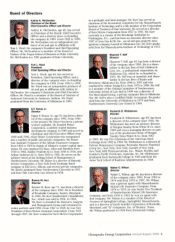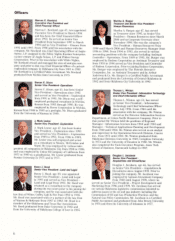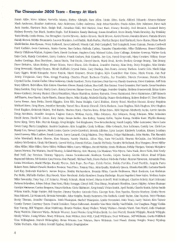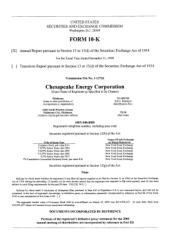Chesapeake Energy 1999 Annual Report Download - page 17
Download and view the complete annual report
Please find page 17 of the 1999 Chesapeake Energy annual report below. You can navigate through the pages in the report by either clicking on the pages listed below, or by using the keyword search tool below to find specific information within the annual report.
We May Have Full-Cost Ceiling Writedowns f Oil and Gas Prices Decline or fDrilling Results are Unfavorable.
We reported full-cost ceiling writedowns of $826 million, $110 million, and $236 million during the year ended
December 31, 1998, the six-month transition period ended December 31, 1997 (the "Transition Period"), and the
year ended June 30, 1997 ("fiscal 1997"), respectively. These writedowns were caused by significant declines in oil
and gas prices during all three periods and by poor drilling results in fiscal 1997 and during the Transition Period.
Additionally, significant declines in prices can cause proved undeveloped reserves to become uneconomic, and long-
lived production to become "economically truncated", further reducing proved reserves and increasing any
writedown. Our reserve values were calculated using weighted average prices at December 31, 1999 of $24.72 per
barrel of oil and $2.25 per Mcfof natural gas. If prices in future periods are below the prices of $10.48 per barrel of
oil and $1.68 per mcf of natural gas used at December 31, 1998, the last period during which Chesapeake recorded
an impairment to its oil and gas properties, future impairment charges could be incurred. Although we have taken
steps to reduce drilling risk, reduce operating costs, and reduce investment in unproved leasehold, these steps may
not be sufficient to enhance future economic results or prevent additional leasehold impairment and full-cost ceiling
writedowns, which are highly dependent on future oil and gas prices.
Drilling and Oil and Gas Operations Present Unique Risks.
Drilling activities are subject to many risks, including well blowouts, cratering, uncontrollable flows of oil,
natural gas or well fluids, fires, formations with abnormal pressures, pollution, releases of toxic gases and other
environmental hazards and risk, any of which could result in substantial losses. In addition, we incur the risk that we
will not encounter any commercially productive reservoirs through our drilling operations. We cannot assure you
that the new wells we drill will be productive or that we will recover all or any portion of our investment in wells
drilled. Drilling for oil and gas may involve unprofitable efforts, not only from dry wells, but from wells that are
productive but do not produce enough reserves to return a profit after drilling, operating and other costs.
Existing Debt Covenants Restrict Our Operations.
The indentures which govern our senior notes contain covenants which restrict our ability, and the ability of our
subsidiaries other than CEMI, to engage in the following activities:
incurring additional debt,
creating liens,
paying dividends and making other restricted payments,
merging or consolidating with any other entity,
selling, assigning, transferring, leasing or otherwise disposing of all or substantially all of our assets, and
guaranteeing indebtedness.
At December 31, 1999, we did not meet a debt incurrence test contained in two of the senior note indentures.
Thus, we will be unable to incur unsecured non-bank debt or resume the payment of dividends on our preferred stock
until we meet the debt incurrence test.
Canadian Operations Present the Risks Associated with Conducting Business Outside the US.
A portion of our business is conducted in Canada. You may review the amounts of revenue, operating income
(loss) and identifiable assets attributable to our Canadian operations in Note 8 of the Notes to Consolidated Financial
Statements in Item 8. Also, Note 11 of the Consolidated Financial Statements provides disclosures about our
Canadian oil and gas producing activities. Our operations in Canada are subject to the risks associated with
operating outside of the United States. These risks include the following:
adverse local political or economic developments,
exchange controls,
currency fluctuations,
royalty and tax increases,
retroactive tax claims,
-7-
























